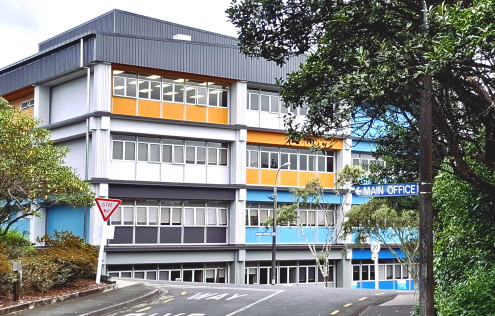New roof and bright colour - a fresh look for WITT
New roofing, a colourful exterior paint job and a range of internal upgrades are part of WITT’s biggest building upgrade in 30 years, giving the main A and B blocks a fresh look.
The project, which started over a year ago, has just been completed. The spruced-up blocks are now clear of scaffolding and white plastic covering in place for the past year.
The $4m project has gone smoothly all the way – a testament to careful planning and project management that ensured classes continued as usual despite being within a construction site, says Director of Support Services, Linda Dravitski.
The four-storey blocks built in the late 1970s, which house classrooms, student health services, a café, computer labs and specialised training facilities – including the Bachelor of Nursing simulation lab, an engineering lab, health and beauty clinic, and hairdressing and barbering studios – are central to the campus.
Re-roofing of both buildings was urgently needed as winter-time leaks became an issue.
During a heavy downpour, staff or students in third floor classrooms occasionally had to grab buckets to catch water leaking through the roof, Linda recalls. This meant water-soaked tiles had to be replaced every year. The issue sometimes resulted in disruption to classes as rooms had to be assessed for health and safety.
“The new re-pitched roof has a steeper gradient to ensure better rain run-off. We won’t need buckets anymore,” says Linda.

Caption: At a gathering to celebrate the project's completion: (left to right) Stefan Pirie – Architect People; Linda Dravitski – WITT Director of Support Services; Jo Lee – RCP, Jonathan Hicks – Livingstone Builders; Nicola Conley – WITT Operations Lead Executive; Lyrae Wood – Kingstons; and Jeremy Powell – Livingstone Builders.
Crown capital funding pot
The much-needed upgrade was funded by the Government’s 2020 investment in Crown owned high priority buildings and signed off by Te Pūkenga in 2022. The work was completed by local construction companies, Livingstone Building, RCP, Architect People and Cunningham Construction to name a few.
“We’re pleased to see the completion of this urgent upgrade to our main buildings,” says WITT Operations Lead Executive Nicola Conley. “Thanks to the special government funding we secured five years ago, we’ve been able to get this work done - it’s been worth the wait. It means our teaching facilities are future-proofed for years to come. We’ve had lots of positive comments about the vibrant colour scheme too!”
“The re-roofing project has been a great boost to the local economy – it’s provided work for over 100 contractors across the trades sector,” says Linda.

What was done to A and B Blocks:
- Re-roofing, recladding of rooftop, skirt and plant room (which houses the lift mechanism, gas, hot water system, ventilation)
- Replaced heating and cooling mechanical systems on level 3
- Installed new downpipes on outside of buildings
- TPO (Thermoplastic Polyolefin single-ply roofing membrane) replaced on every floor and the lower B-block roof
- Exterior painted– colour scheme to reflect WITT’s brand colour palette.
- Detailed seismic assessment completed to ensure current standards are met
Waste not – diversion success
Additional spinoffs of the project include a highly successful waste management plan that achieved 90 per cent diversion of all waste materials – an outcome reported by Livingstone Building’s site team. The results reflect WITT’s commitment to sustainability, says Linda.
Metal and timber made up the bulk of the waste from the large roof area. Steel roof sheets were recycled to Energy City Recyclers in New Plymouth. Sarking (a method of interior construction widely used in Australia and New Zealand where wooden panels are nailed over the beams and joists of a building frame) - in this case plywood sheeting - was layered beneath the steel roofing.
The site team identified opportunities to re-use much of the 14 tonnes of sarking on other Livingstone sites in Taranaki.
Examples of this use include:
- Providing protection from falling objects at the Downtown Carpark Seismic Upgrade project.
- Cut for use for temporary works at the CC Ward restoration site.
- Installation as boundary hoarding during the new build of The Junction – Zero Waste Hub at Colson Road.
“It’s a win-win that this re-use aligns with the core principle of The Junction to divert materials from landfill. Keeping the material in a circular movement locally has also minimised carbon emissions from landfilling or the manufacture of new product,” says Livingstone Building Project Manager, Jonathan Hicks.
“The project embeds our everyday sustainability initiatives, which has been a focus of WITT campus operations for some time, both at a decision-making level and a practical level involving infrastructure improvements,” Linda says.
Learning opportunities for trades students
The re-roofing project also offered the chance for a field trip on campus and hands-on learning for WITT trades ākonga.
Mid-way through last year a group of plumbing students ascended Block A via an external cage lift to learn about health and safety as part of the New Zealand Certificate in Plumbing, Gasfitting and Drainlaying.
Tutor Brendon Metcalfe said the rooftop trip was a chance to “get the class onto a commercial worksite and to go through the health and safety induction and accessing the site procedures.”

Caption: Plumbing students preparing to take the scaffolding lift to check out the roofing project.
Green between – landscaping the last phase
The final phase will focus on the design and landscaping of the outdoor plaza area between the two blocks to include seating, gardens and artwork. This is expected to be underway from 2026.
Linda is particularly pleased that the entire project was carried out without any major interruptions to classes – a testament to the careful logistical planning with contractors to ensure, for example, noisy machinery was not in use during exam times.
The support from the community for the re-roofing project has been enormous, she says. "It’s an investment into the students, this kura and local delivery of vocational education in the Taranaki region.”
Caption: Top image: Nicola Conley – WITT Operations Lead and Linda Dravitski – WITT Director of Support Services.